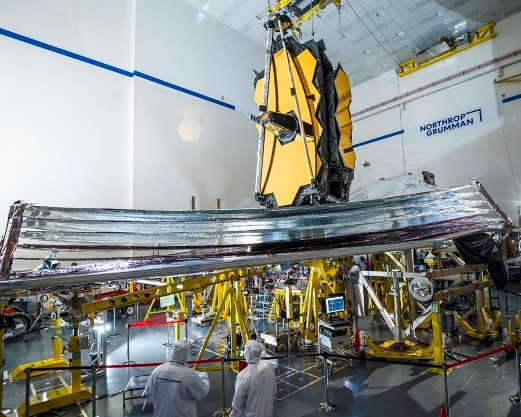Webb Telescope sunshield open successfully in line with pre-launch testing carried out in California a year ago
The 70 foot sunshield had been folded inside the payload area of an Arianespace Ariane 5 rocket’s nose cone prior to launch and has now been successfully deployed to provide protection to the James Webb space telescope from the sun’s rays.
As part of the mission, which is the first time anyone has ever attempted to put a telescope as large as this one into space, the sunshield was subject to an intricate and careful deployment operation. Thomas Zurbuchen of NASA’s Science Mission Directorate says the success of the most challenging deployment of the mission, the sunshield, is an incredible testament to the human ingenuity and engineering skill that will enable Webb to accomplish its science goals.
The five-layered sunshield will protect the telescope from the light and heat of the Sun, Earth, and Moon. Each plastic sheet is about as thin as a human hair and coated with reflective metal, providing protection on the order of more than SPF 1 million. Together, the five layers reduce exposure from the Sun from over 200 kilowatts of solar energy to a fraction of a watt.
This protection is crucial to keep Webb’s scientific instruments at temperatures of 40 kelvins, or under minus 380 degrees Fahrenheit – cold enough to see the faint infrared light that Webb seeks to observe.
The unfolding and tensioning of the sunshield involved 139 of Webb’s 178 release mechanisms, 70 hinge assemblies, eight deployment motors, roughly 400 pulleys, and 90 individual cables totaling roughly one quarter of a mile in length.
The world’s largest and most complex space science observatory has another 5 1/2 months of setup still to come, including deployment of the secondary mirror and primary mirror wings, alignment of the telescope optics, and calibration of the science instruments. After that, Webb will deliver its first images.
The feat was achieved after months of testing on the ground at Northrop Grumman in Redondo Beach, California before launch. The testing was performed not only to verify the deployment mechanisms but also to ensure the equipment was capable of withstanding the hostile environment of space.
- UK manufacturing steps up to COVID-19 crisis - April 2, 2020
- Clustering Innovation - March 12, 2020
- A Global Monitor - March 6, 2020

